Family : Felidae

Text © DrSc Giuliano Russini – Biologist Zoologist

English translation by Mario Beltramini
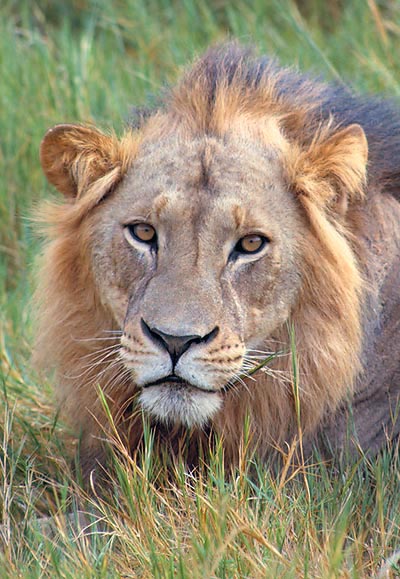
The mane is a clear character of sexual dimorphism © G. Mazza
The Lion (Panthera leo Linnaeus, 1758), member of the order Carnivora and of the family of the Felidae, is the greatest and most dangerous predator of the African continent, as the Tiger (Panthera tigris) is for Asia, and, by sure, of all the carnivorous, tetrapod, placentate, terrestrial mammals of the planet.
As we have treated briefly in the introductory text about the family of Felidae, it is quite consolidated, through zoo-paleontological data gotten form fossil skeletons, zoo-genetic data on biologic samples of present specimens, that all modern lions come from a common ancestor. After the biologist zoologist O’Brien, the African species (Panthera leo) and the Indian race (Panthera leo persica) should have the same progenitor which lived between the end of the middle Pleistocene and the beginning of the last Würm glacial period, between 200.000 and 55.000 years ago.
Also, because the mane is a somatic character obtained by the lions in rather recent times, 300.000-200.000 years ago, and in Europe, and probably also in North America, the lions with the mane did coexist with the maneless ones since from about 300.000 years ago.
During the evolutionary processes, other descendents of this forefather were living in places where the lions are not present anymore, in very vast ranges and very different from present habitats, with by this time extinct subspecies and races. Among these, we recall the American Cave Lion (Panthera leo atrox), whose fossil skeletons have been found in North America, and the Eurasian Cave Lion (Panthera leo spelaea), with fossil skeletons found in Siberia, Russia and Poland.
Nowadays, many biologists zoologists think that all the African lions living in different areas of Sub-Saharan Africa, should be, as a matter of fact, considered as a unique subspecies deriving phylogenetically from the Atlas or Barbary Lion (Panthera leo leo). But many authors assert that attributing to the Panthera leo only one subspecies or race, the Panthera leo persica , endemic to the isolated Indian forests of the Gir, is in reality, very reductive.
It is sufficient, in fact, to observe the mane, well evident in the African lions and little less in the Indian ones, which have, on the other hand, a vast ventral band, changing of colour and dimensions depending on the geographic area, apart from the level of plasmatic testosterone. When this develops in the males, around the third year of life, once the sexual maturity is reached, the more or less imposing look and the intense colours, from the dark brown or burnt brown to the almost black, does not depend only from endocrine-sexual factors, but also from the habitat itself. In the zoological gardens of North Europe and North America, for instance, the manes are thicker, probably for protecting the animal from the more rigid temperatures, whilst the brothers of a same litter, grown in tropical zoological gardens, have different colour and dimensions. All these factors have led some zoologists to consider the Panthera leo, besides the Panthera leo persica, as having the following geographic subspecies.
Among the extinct ones:
– Panthera leo spelaea, which probably lived between 300.000-10.000 years ago in the upper Pleistocene.
– Panthera leo atrox, probably lived between the 35.000-10.000 years ago.
– Panthera leo europea, probably lived till the 100 A.C., called also European Lion. It was spread over the Balkans, Italy, southern France and northern Spain. It was exterminated by the pitiless hunt of Romans, Macedonians, Gauls and Iberians. By that time, in Italy as in France, vast temperate forests were existing, followed later, due to climate changes and urbanizations, by a modification of the eco-systems, in particular, by a furtherance of the typical Mediterranean brushwood.
– Panthera leo sinhaleyus, the Sri Lanka or Ceylon Lion.
– Panthera leo vereshchagini, the East Siberian or Beringian Cave Lion.
– Panthera leo youngi, the north-eastern China Cave Lion, lived in the Pleistocene, about 350.000 years ago.
– Panthera leo leo, the Barbary, or Atlas or Nubian Lion, extinct from 1946, of which we have been extensively talking in the introduction to the Felidae. Till the beginning of the ‘900, the biologists were classifying it also as Panthera leo berberisca.
– Panthera leo maculatus, extinct from 1930, called also Spotted Lion or Marozoi. The controversy between the biologists zoologists in considering it as a subspecies or race of the Sub Saharan Panthera leo is still open, as the maculation these lions had, after some authors was to be deemed as an involuntary biologic hybridization caused by the casual coupling of a lion and a leopard (male of Panthera leo × female Panthera pardus or vice versa).
– Panthera leo melanochaita , the Cape Lion, extinct from 1860.
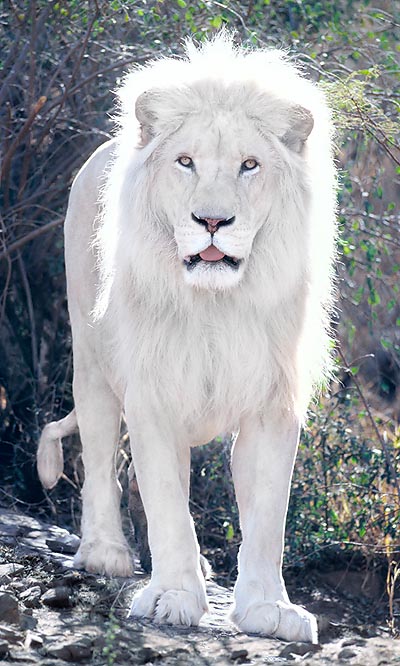
White lion of Timbavati © Giuseppe Mazza
Between the still extant species:
– Panthera leo persica , confined in the forests of the Gir in India, were are no more than 350 specimens, even if, in the past, the same was present also in Bangladesh, Turkey, and Middle East, but as it had the tendency to go hunting during the day, instead of the night, it was an easier prey for the poachers.
– Panthera leo goojratensis , the true Indian Lion, by now extinct, after many zoo-biologists.
– Felis leo roosevelti, the Abyssinian Lion, presently classified as Panthera leo roosevelti. With this name was classified during the first half of the last century, an Ethiopian subspecies with black mane, nowadays, even if there are still some dozens of specimens existing, it is not anymore considered as a geographic subspecies different from the Panthera leo.
– Panthera leo bleyenberghi, called Katanga or Southwest African
– Panthera leo hollisteri, the Congo Lion.
– Panthera leo krugeri, the South African or Southeast African Lion.
– Panthera leo massaicus, the Masai Lion, present in Kenya and Tanzania.
– Panthera leo somaliensis, the Somali Lion.
– Panthera leo nubica, the East African Lion.
– Panthera leo senegalensis, the Senegal or West African Lion.
– Panthera leo verneyi, the Kalahari Lion. In this race or subspecies, the biologists have noted an ethology and an anatomy more differentiated from the Panthera leo than the others aforementioned.
This classification is, however, not accepted by all, even if some morphologic and ethologic differences are quite certain in the populations of the different geographic areas.
A certain number of natural variations, at times facilitated by the captivity status, have been remarked. For what it concerns the variety called leucism (white coloured coat), this is at times observed in lions endemic to Timbavati, in South Africa. The scientific name is Panthera leo krugeri , called also Transvaal Lion (from the name of a former South African province), called also South African Lion, which is the greatest lion, the males reaching the weight of 260 kg, per a length of 2,97 m, whilst the females, at the best, can reach the weight of 190 kg, per a length of about 1,90 m. The presence of completely white coat and mane (leucism: from the Greek λευκοσ, leucos, white ; the animals are called leucistic), is thought to be the effect of two possible mechanisms. The first one, is that of the expression of a recessive gene (called chinchilla or colour inhibitor), in charge of the inhibition of the expression of the melanin (the chromo pigment colouring the coat, the fur, the feathers of the animals, human skin included) through the melanocytes, which, being in the combination of homozygosity, should be the reason of this variation. In particular, we cannot talk of a distinct subspecies in the case of leucistic lions, but, rather, of a case of genetic polymorphism, related to a condition of leucism which causes a colouration, pale and similar to that of the white tigers. The condition is not similar, even if with opposite effects, to the melanism typical of the black panther (Panthera pardus) and of the black jaguar (Panthera onca). This is confirmed also by the colour of its eyes, which is not red, typical of the albino animals, but is the same as that to its wild type likes, usually blue. This colouration penalizes the lions in the wild, as they are easily seen by the preys, which in this way are able to run away; in the wild, therefore, a white lion is condemned to death for starvation.
Keeping in mind that the albinism is an hereditary anomaly consisting in the deficiency or degeneration of the melanic pigmentation in the skin, hair, feathers, choroid, iris characterized by a recessive phenotype, determining the lack of the tyrosinase enzyme associated with the ocular-cutaneous albinism, and therefore it manifests in individuals born from parents both albino or heterozygous for this phenotype. In nature, it does not affect the human being only, but also other mammals, birds, reptilians, amphibians and fish, and manifests with various degrees of dangerousness, so we go from the ocular albinism to the ocular-cutaneous affecting the whole body, to the partial albinism and, finally, to the total albinism, the most dangerous, being the body completely missing of melanin and practically all white, even the hair having a straw colour and being very frail.
Furthermore, the leucistic lions differ from the albino organisms because not characterized by heliophobia, that hypersensitivity to the light which, due to the prolonged exposition to the sun, causes serious damages to the eyesight and the body of the albinos. On the contrary, having a high albedo (from the Letin albedo, “whiteness”, from album, “white”: the capacity of reflecting the light), they are indeed more resistant to the sun than the normal or melanic species as they absorb a minor quantity of rays.
Recently, however, another hypothesis, confirmed by the molecular biology, has taken form, after which the leucism might be caused by phenomena of epistasis done by regulating-inhibiting genes, which act, because activated in the leucistic lions, antagonizing the gene(s) which regulate the expression of the melanin. The leucistic lions come to life almost completely white, without the normal spots of camouflage found in the lion cubs. Their colour darkens gradually so much to become of a cream or ivory colour, this last known with the name of blond.
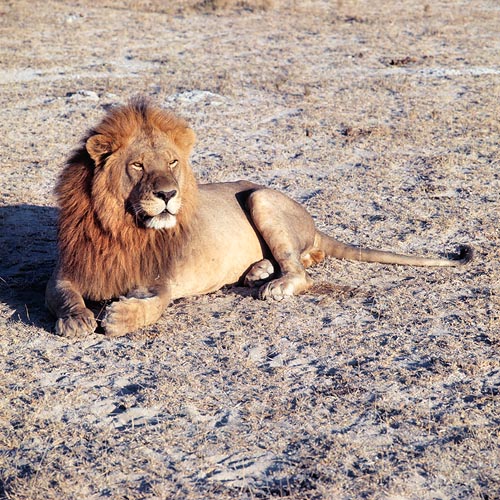
The dominant male lion has an indispensable role in the defence of the territory © Mazza
With regard to the hybridizations, the lions have been coupled with the tigers (more frequently with the Amur and Bengal ones), for creating hybrids called Ligers and Tigons, with the leopards for generating Leopons, and with the jaguars for getting Jaglions. The Marozoi is deemed to be a maculated lion or a leopon produced naturally, whilst the maculated Congo lion is a complex lion/jaguar/leopard hybrid called Lijagulep. Some hybrids were once bred commonly in the zoos, but this activity has been now discouraged by the emphasis given by the species and subspecies conservation. Hybrids are still bred in private farms and zoos in China.
The Liger is the crossing between a male lion and a female tiger. As the lion parent carries a gene promoter of the growth (which regulates the expression of the somatotropin hormone or of the growth, also called of the gigantism, GH), but the corresponding gene inhibitor of the growth coming from the female tiger being absent, the ligers reach bigger dimensions than those of both their parents. With dots and stripes on a sandy coloured background, they have the physical and behaviour aspects of both parents’ species. The male ligers are sterile, but the female ones are often fertile. The less known Tigon is a crossing between a lioness and a male tiger. As the male tiger does not have a gene promoting the growth and the lioness has a gene inhibitor to the growth, the tigons are often somewhat small, weighing only no more than 180 kilos, 20% less than the lions. Like the ligers, they hold physical and behaviour tracts of both parents’ species and the males are sterile, whilst the females may be fertile.
From data furnished by the IUCN and the CITES, they calculate that presently in the world there are about 30.000-35.000 lions free in the wild, confined in the various natural African and Indian reserves. By the end of the eighties, the WWF had informed that there were about 100.000 wild lions.
The causes of this significant decrease, in an already low density population, are thought to be several, as it is the case for many other animal species. The hunting, still practiced in Africa and Asia, and the reduction of the home-ranges. In spite of the efforts done by the biologists and rangers nowadays, forming natural reserves, these tend inevitably to reduce, not to talk about the rarefaction of the preys. And, at last, there is also a series of infective pathologies by bacteria, virus and protozoans, introduced by domesticated cats, dogs and herbivores of the nearby farms; sicknesses which are decimating the lions as they have an immune system not prepared for this event, due to their different natural history. As a consequence, both the Panthera leo and the Panthera leo persica belong, along with the Panthera tigris and its various races, to the Red list of endangered threatened species of the IUCN, and many are the programmes started, both in Europe and in USA in cooperation wit the African and Asiatic biology institutes and many zoological gardens, zoo-safaris and zoo-parks for the protection, conservation and reproduction of the species.
Zoogeography
In prehistoric times, till the late Pleistocene, the range of the lions included Africa, Eurasia and North America. During the last Würm glacial epoch there were several species of cave lions, measuring about the 25% more than the modern lions. Later on, probably in concomitance with the disappearance of the megafauna and the increase of the temperatures, the lions disappeared from the northern regions of Eurasia and North America. They moved to the present African and Asiatic continent where they were found everywhere.
With the increase of human instalments, they were then decimated pitilessly, also because they were dangerous animals, and even now in Africa, one of the first causes of death of humans by wild animals is the lion, with the hippopotamus (Hippopotamus amphibius), the African elephant (Loxodonta africana) and the African buffalo (Syncerus caffer), whilst in India the statistics place in evidence the Indian rhinoceros (Rhinoceros unicornis), the Indian elephant (Elephas maximus) and the tiger (Panthera tigris).
The lion lives nowadays in Africa, in the sub-Saharan part of the continent, in nations such as Cameroun, Congo, Kenya, Tanzania, Senegal, South Africa, Somalia and Ethiopia, where it is confined in reserve parks. Some rare specimens are still found in the Arabic desert, in Asia Minor. In India, it is confined in the isolated forests of the Asiatic south-eastern Gir and in the national Park of the Sasan-Gir (1412 square km) in the state of the Gujarat. With the aim of protecting this small population from epidemics and other habitat risks, a programme of reintroduction of the Asiatic lion is effective also in the Palpur-Kuno Wildlife Sanctuary, a natural reserve in the nearby state of the Madhya Pradesh, in collaboration with European, Chinese, Indian and Russian biologists.
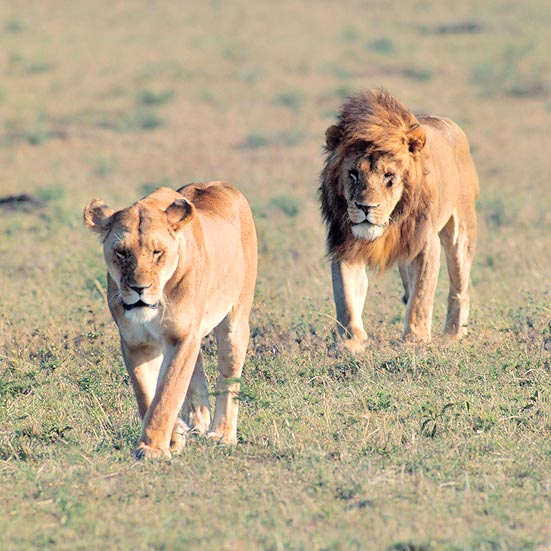
Lions can couple any time during the year © Giuseppe Mazza
Habitat-Ecology
In Africa, the lions are swaying over the savannah and the prairies, up to the bush and in more humid zones with thickets of canes, but we find them also in semi-desert areas at the limits of the arboreal vegetation, and in the small woody areas typical of the sub-Saharan ecosystem which form that classical forestation, characteristic in Africa, defined as leopard spotted, formed by succulent plants and, mainly, by trees of Acacia tortilis.
They are euriphagous, which means that they adapt very well to eat a vast choice of herbivores, of small, and even better, great dimensions. And when the food lacks, they adapt also to a diet of insects, small reptilians and amphibians.
The alimentary ecology may differ depending on the geographic location. The Congo lions have been sighted many times while attacking the giraffes (Giraffa camelopardalis) and the okapis (Okapia johnstoni). The lions of the zone of the river Savuti-Botswana are specialized in hunting young elephants, and those living close to the river Cuando-Botswana, mainly eat hippopotami. The attack to preys belonging to unusual species is initially justified by the scarcity of food, but it can, later one, become a habit. In several instances, acquired behaviours of this type have transformed the lions in hunters of men, the so-called “man-eaters”.
Morpho-Physiology
Apart the discussion on the races, the sexual dimorphism of the mane of the male lions seems evident. The mane remarkably amplifies the dimensions of the head, and its function is not yet well clear to the biologists, even if it is thought that it is utilized as a defence instrument, during the fights with the likes, for avoiding wounds to the throat. If we talk about hunting, on the contrary, especially during the dry season, when the savannah is subject to fires and the vegetal coverage is reduced, the mane may become a limitation factor. However, after all, the problem does not hold good, as, almost always, it’s the females which are caring the food.
The males can weigh even 220-240 kg, with a length of 250-270 cm and 120-130 cm at the withers; the females 170-200 kg with a length of 190 cm and 110-115 cm of height. In the Indian lions, the reduced dimension of the mane seems to depend, more than on local factors, on a high percentage of akin crossings.
The males and the females of Panthera leo and Panthera leo persica have, like the tiger, retractile claws which can be even 6 cm long. They have a digitigrades walking, and the pads under their feet allow them to go ahead in silence, thus avoiding to be sighted.
Upon the birth, in both sexes, and till the sexual maturity, the nose has pale pink, then darkens increasingly, to become finally completely black in the oldest specimens.
Both sexes have are powerfully muscled, and can therefore prevail on all the carnivores present in their ecotype and on almost all terrestrial mammals. Obviously, they will never be able to knock down adult elephants (Loxodonta Africana) or rhinoceroses (Diceros bicornis, Ceratotherium simum), unless these ones are already seriously sick and enfeebled.
The tail is mighty and can reach one metre of length. Between all members of the Felidae, the lions are the only ones (both males and females) having a tail which ends in a tuft of black hair, with a bone inside. The function of the same is unknown. The tail is of use for keeping their balance while jumping in the ambushes, when hunting, where they can effect 10-12 m long and 3 m high leaps!
They can reach the 70-75 km/h with the sprint, but they are little resistant, as they can maintain this speed only for about 150-200 m.
They have the typical carnivores’ dentation, with developed incisors, ferine teeth (particular molars), fit for tearing off the flesh they are swallowing, and canines long even 8-10 cm, well steady, with a 5 cm diameter root. They have an oro-pharyngeal apparatus made in such a way that, when roaring, they emit baritone sounds which can be heard 3-4 km far away, profiting also by atmospheric factors like the “Theory of thermal inversion”, proposed by the biologist Frumkin in the seventies, and described in our introduction to the Felidae, has demonstrated.
They have very acute eyesight which permits them to find a prey or a competitor of the same species even at a distance of 2 km. Like the other Felidae and Canidae, the lions cannot distinguish the colours: they are colour-blinded as they perceive only the various tonalities of grey and the black, but, on the other hand, they can very well see during the night time.
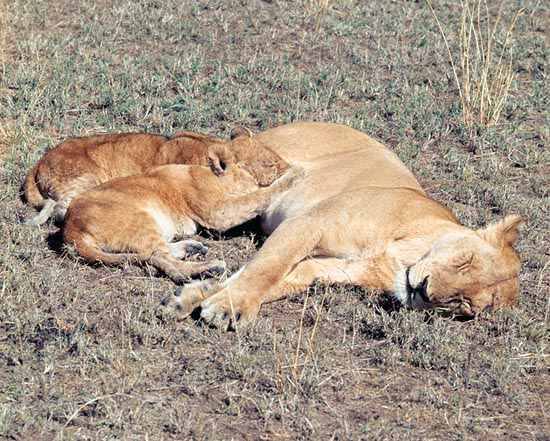
The lionets are well accepted in the herd and the mothers often nurse also others’ sons © G. Mazza
Ethology-Reproductive Biology
The lions usually live in sedentary herds formed by akin females, their cubs, an old female and an adult male, or by a so-called “coalition” of adult males (up to 8-9), with groups which can have 30 units. The males, once reached the sexual maturity, are driven away from the herd and usually wander around looking for another group to rule by defeating the dominant male or males. A male which does not succeed in imposing itself over a herd becomes usually a rover and roams about, even for great distances, alone, or together with other males.
The distribution of the roles is much more prominent than for other species inside the herds of lions. If on one hand the hunting activity is an almost exclusive attribute of the females, the males do not have a less important role. In fact, they have to explore the territory, defend the seized preys from possible intruders, and protect the herd, especially the young, from other male lions or other possible predators.
This exposes them continuously to direct fights with other lions, hyenas, leopards and cheetahs, and so it has rendered the lions perfect fighters, shaped by the natural selection. The young males, with a rather short mane, are fairly good hunters, even if not as good as the lionesses, whilst the adult males occasionally take part to a hunt is the prey is a particularly strong animal, like a buffalo or a giraffe, which can weigh even two tons. In spite of its huge mass, the lion is an exceptionally agile animal: it can climb the trees, swim and effect jumps. The killed prey is quickly carried in a sheltered place, where the herd can defend it against opportunist predators like hyenas, jackals and vultures. By the time of feeding, quarrels and scuffles inside the herd are quite common, and usually tend to confirm the hierarchical relations, with the adult males usually eating the first, followed by the females and finally by the young. In many instances, the male lion follows other predators such an African wild dog or a cheetah, intervenes once these ones have killed the prey, and seizes the remains.
A peculiar characteristic, which is found, probably as ancestral heritage also in the tamed cats, is that the males emit two types of urine. The first, sprayed while walking with jets which can assume the inclination of about 90°, where are present high concentrations of pheromones, acting as biologic trace, specific to the animal, for marking the territory along with the roars; the second one, emitted while crouched, which does not have particular bio-chemical characteristics and is utilized only for emptying the bladder.
The female has the typical placentation of the carnivores: a zonary placentation where the chorionic villi are organized in an annular band. They can couple any time during the year, even if in South Africa, the births are more frequent in autumn and winter. Both males and females are polygamous, the deliveries are multiple, the cubs, upon the birth, weigh 1,50-1,60 kg and have a maculated coat which will disappear, in the males, with the growth, after the moulting. It persists, at times, in the females. The infantile maculation is a mimetic mechanism, useful for the cubs, when the are left alone by the mother during the hunt, for hiding in the brushwood thus avoiding to be killed, as at times happens, by hyenas and lycaons. The gestation lasts hundred-hundred twenty days and the female delivers 1 to 4 cubs, not necessarily all conceived with the same father. The females of a herd synchronize their reproductive cycles in such a way to cooperate in the breeding and the suckling of the young, which can consequently nourish from any female. The cubs are weaned after 6-7 months. In the wild, due to the hard competition for the food, the 80% of the cubs passes away within the two years of life.
When a new male (or a coalition) assumes the rule of a herd sending away the previous master (or masters), the new leader/s often will kill every cub younger than two years so that the females, ceasing the suckling or being unable now to breed the cubs, become again fertile and available for the mating. At times, a female tries to defend its own cubs from the new dominating male, often in vain. The male lions reach the maturity when about 3 years old (the females around the fourth year of life) and are able to assume the rule of another herd when 4-5 years old. They begin to get old and weaken when about 8 years old. A male, therefore, has a rather short time available for getting the rule of a herd and create its offspring. The lions reproduce very easily also in captivity. In the wild, they can live about sixteen years; when captive they can live about ten years more.
Synonyms :
Felis leo Linnaeus, 1758.
→ For general information about Felidae please click here
